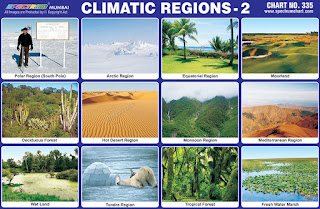 |
| Climatic Regions 2 Chart |
Spectrum Chart - 335 : Climatic Regions 2
1. Polar Region (South Pole) – Polar
regions are dominated by Earth's polar ice caps, the southern polar
region is resting on the continent of Antarctica. South Pole has a
desert climate, almost never receiving any precipitation. Air
humidity is near zero. However, high winds can cause the blowing of
snowfall. The southern polar region has no permanent human
habitation.
2. Arctic Region – Arctic region is a
polar region located at the northernmost part of Earth. The Arctic
consists of the Arctic Ocean and parts of Alaska (United States),
Canada, Finland, Greenland (Denmark), Iceland, Norway, Russia and
Sweden. Arctic's climate is characterised by cold winters and cool
summers. Precipitation mostly comes in the form of snow.
3. Equatorial Region - Equatorial regions
are located in a band around the Equator and cover about 6% of the
Earth's surface. They are often in lowland areas and have a climate
that is hot and wet all year round. Tropical rainforests grow in the
equatorial regions.
4. Moorland – Moorland is a type of
habitat found in upland areas in temperate grasslands, savannas, and
shrublands and montane grasslands and shrublands biomes,
characterised by low-growing vegetation on acidic soils. Moorland
nowadays generally means uncultivated hill land. Moorland habitats
are most extensive in the neotropics and tropical Africa but also
occur in northern and western Europe, Northern Australia, North
America, Central Asia and the Indian subcontinent.
5. Deciduous
Forest - Deciduous forest, vegetation composed primarily of
broad-leaved trees that shed all their leaves during one season.
Deciduous forest is found in three middle-latitude regions with a
temperate climate characterised by a winter season and year-round
precipitation, eastern North America, western Eurasia and
northeastern Asia. Oaks, beeches, birches, chestnuts, aspens, elms,
maples and basswoods are the dominant trees in mid-latitude deciduous
forests.
6. Hot Desert Region – A desert is a
very dry biome. They get less than 25 cm (about 10 inches) of rainfall
a year. Hot deserts are mostly in the subtropics. They can be covered
by sand, rock, salt lakes, stony hills and even mountains. The Sahara
desert is the hottest desert region in the world.
7. Monsoon Region – Monsoon region
receives the high amount of rainfall during the monsoon season.
Region consists of high amount of green vegetation. Waterfall can
also found in such regions.
8. Mediterranean Region - Mediterranean
region is the region of lands around the Mediterranean Sea that have
a Mediterranean climate, with mild, rainy winters and hot & dry
summers, which supports characteristic Mediterranean forests,
woodlands and scrub vegetation. Mediterranean region covers portions
of three continents Africa, Asia and Europe.
9. Wet Land – A wetland is a land area
that is saturated with water, either permanently or seasonally, such
that it takes on the characteristics of a distinct ecosystem.
Wetlands play a number of roles in the environment, principally water
purification, flood control, carbon sink and shoreline stability.
Wetlands are also considered the most biologically diverse of all
ecosystems, serving as home to a wide range of plant and animal life.
10. Tundra Region – Tundra region is a
type of biome where the tree growth is hindered by low temperatures
and short growing seasons. In tundra, the vegetation is composed of
dwarf shrubs, sedges, grasses, mosses and lichens. Scattered trees
grow in some tundra regions. The climate in a tundra region consists
of freezing cold and dryness in the winter and cold summers.
11. Tropical Forest – Tropical forests
are usually found in areas receiving more than 200 mm of rainfall and
having a temperature of 15 °C to 30 °C and have annual humidity
exceeding 77%. Tropical evergreen forests are dense, multi-layered
and harbour many types of plants and animals. The canopy tree species
are mostly tall hardwoods with broad leaves that release large
quantities of water through transpiration.
12. Fresh Water Marsh – A freshwater
marsh is a marsh that contains fresh water. Freshwater marshes are
usually found near the mouths of rivers and are present in areas with
low drainage. Freshwater marshes are non-tidal biomes containing
little or no peat. Freshwater marshes support an independent
pH-neutral ecosystem which encourages biodiversity. Common species
include ducks, geese, swans, songbirds, swallows, coots and black
ducks.

No comments:
Post a Comment